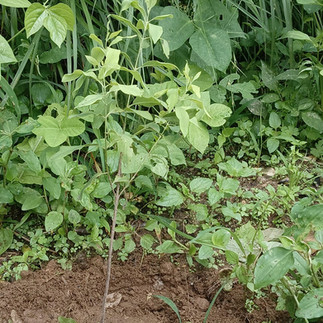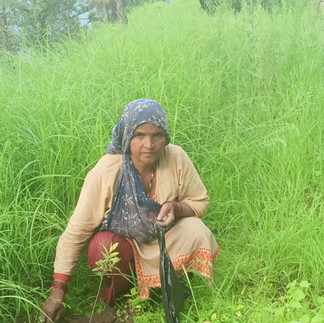Afforestation
Objective
The objective of this project is to implement afforestation in the villages where the farmers are unable to harvest their land due to migration and wild animals. We will work with the local communities to plant trees that produce fruits and wood, providing both environmental and economic benefits.
The villagers will be paid to take care of the trees, creating job opportunities and income for them. We will choose those trees that produce fruit or woods so that they are valuable for the villagers and they take care of them. promote the use of smokeless chulhas for cooking in households. The aim is to reduce indoor air pollution, promote a cleaner environment, and improve the health of women and children in rural areas. This project will contribute towards achieving the Sustainable Development Goals (SDGs) related to clean energy, health, and the environment.
Benefits of Afforestation
Afforestation has a significant impact on climate change. It can help to reduce carbon dioxide levels in the atmosphere by sequestering carbon in the trees and the soil. Moreover, it can help to prevent soil erosion and reduce the impact of floods.
Afforestation also has several socio-economic benefits. It creates job opportunities for the local communities, generates income, and provides the opportunity to harvest fruits and wood from the trees. This project will also help in the overall development of the community.
Accomplishment till now
Land Identification: We have Identified suitable land for planting trees in consultation with the local community. We will be using the private land of the villagers which is currently unused due to less number of people in the village and the wild animals destroying the crop.
Baseline Survey: We have conducted a baseline survey to assess the existing vegetation, soil quality, and water availability. This will help in choosing the appropriate species of trees for the project.
Appointment of Consultant/Project Coordinator: We have appointed Consultant/Project Coordinator who will be working with us in the plantation work.
Species for plantation: We will plant Chandan (Sandalwood) plants with some plants, which will support the local ecosystem. Our aim is to create a sustainable and resilient forest ecosystem that will provide long-lasting benefits to the environment and local community
Target Location
Village-Ghughuti, District-Almora, Uttarakhand, India.
Planted 200 Trees (150 Sandalwood and 50 host plants)
We have successfully planted 200 trees (150 Sandalwood and 50 host plants) and in the next phase ,we will plant further 150 Sandalwood plants with 50 host plants as a part of our commitment to environmental sustainability.These trees represent not just a greener landscape but a symbol of our dedication to a healthier planet.
Work for Sustainability of Trees
For nurturing these trees, we are proud to have created employment opportunities for a selected group of individuals who are actively involved in caring for these plants.This initiative not only contributes to the well-being of our environment but also supports the livelihoods of our community members.
Pictures of Afforestation Work (2024-2025):
Glimpse of Site Visit Previously Planted 300 Sandalwood Plants Progress
Pictures of Afforestation Progress(Planted 300 Sandalwood plants with 100 Host plants in the Financial Year 2023-2024):
Maintenance and Monitoring (FY 2024-2025):
From April to August 2024, the primary focus was on the maintenance of the planted sandalwood saplings.
The team regularly visited the site for monitoring plant health, applying fertilizers, addressing pest control, and maintaining proper irrigation.
We have been successful in ensuring that a majority of the plants have thrived and are showing healthy growth
Pictures, Videos and Testimonials are shared below
Accomplishment
- Plant Survival Rate: 60% of the sandalwood saplings have survived, and 50% of the supporting plants are flourishing, providing much-needed support to the ecosystem.
- Community Engagement: Local communities, especially women, have been instrumental in maintaining the plantation, aligning with our goal of empowering them through environmental initiatives.
- Ecosystem Restoration: The supporting plants have helped maintain soil fertility and provide a favorable environment for the sandalwood to thrive.
Impact:
The plantation project has created a significant positive impact on both the environment and the community:
- Environmental Impact: Restoration of green cover, improved soil health, and increased biodiversity.
- Social Impact: Empowerment of local communities through participation in sustainable practices. Moreover, we have created 4 jobs.
Challenges we faced:
Here are the challenges faced in planting sandalwood plants at the site of Ghughuti village, Almora, detailed for the progress report:
1. Frequent Wildfires:
- The jungle near the plantation site caught fire during the summer, particularly at night, which posed a significant threat to the sandalwood plants. Wildfires spread rapidly and can cause extensive damage to the surrounding area.
- The villagers came together to combat the fire using traditional methods like water, sticks, and mud, successfully putting it out. Despite this collective effort, the incident still impacted the overall health and survival of the plants.
2. Water Scarcity:
- Water scarcity during the summer months presented a major challenge. The delayed or insufficient monsoons caused water sources to dry up, making it difficult to consistently water the sandalwood plants.
- Sandalwood plants, especially in their early stages, require significant care and consistent watering for at least the first year and a half, making this a critical challenge.
3. Excessive Rainfall and Floods:
- On the other hand, when the rains did arrive, they were often excessive, leading to floods in the mountainous areas. Flooding caused soil erosion and damage to both the sandalwood and host plants.
- Flooding also hindered the proper growth of the plants, as they were occasionally submerged or damaged by water runoffs.
4. Accidental Damage by Farmers:
- Another challenge arose from local farmers working in the fields. Inadvertently, some sandalwood plants were damaged by farming activities, such as plowing the fields. This accidental harm contributed to the reduced survival rate of the plants.
5. Intensive Care Required:
- Sandalwood plants need intensive care and attention, especially during their first 1.5 years of growth. Despite the team's hard work, these challenges limited the overall success rate of the plants.
Conclusion: Despite these numerous challenges, we worked diligently to save and nurture the plants, resulting in a 60% survival rate for the sandalwood plants and a 50% survival rate for the host plants. This outcome highlights both the obstacles faced and the perseverance shown in maintaining the plantation.
Pictures of Challenges faced:
We will educate villagers benefits of Afforestation and benefits of planted trees:
Empowering Our Villagers Through Education on Afforestation and Tree Plantation.
Educating villagers about the importance of afforestation and the benefits of cultivating chandan (sandalwood) plants.
Through informative sessions and workshops, we will empower our community members with valuable knowledge about the positive impact of afforestation on the environment and the numerous advantages of cultivating these specific tree varieties.
The benefits highlight include:
1. Environmental Conservation:
Afforestation contributes to a healthier environment by enhancing air quality, preventing soil erosion, and promoting biodiversity.
2. Economic Opportunities:
The cultivation of chandan trees not only aids in environmental conservation but also opens up economic opportunities for our villagers through sustainable harvesting and sale of these valuable resources.
3. Medicinal and Aromatic Properties:
Chandan is renowned for its medicinal and aromatic properties.
4. Carbon Sequestration:
Trees play a crucial role in mitigating climate change by absorbing and storing carbon dioxide. Afforestation with chandan trees contributes significantly to carbon sequestration.
We believe that by fostering a deeper understanding of these benefits, we are not only promoting sustainable practices but also paving the way for a more prosperous and environmentally conscious community.
Thank you iQor services Pvt Ltd for your continued support in our efforts towards a greener and more sustainable future.














































Comments